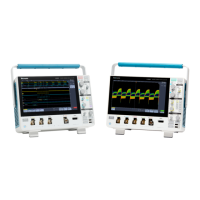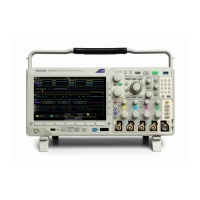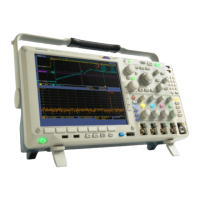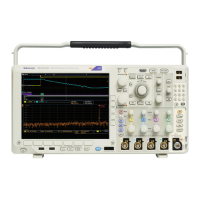Specifications
Table 6: Trigger specifications (cont.)
Characteristic Description
Video trigger
formats and fi eld
rates
Triggers from negative sync composite video, field 1 or field 2 for interlaced systems, any field, specific
line, or any line for interlaced or non-interlaced systems. Supported systems include NTSC, PAL,
SECAM.
Standard Video formats are: Trigger on 480p/60, 576p/50, 720p/30, 720p/50, 720p/60, 875i/60,
1080i/50, 1080i/60, 1080p/24, 1080p/24sF, 1080p/25, 1080p/30, 1080p/50, 1080p/60, and custom
bi-level and tri-level sync video standards.
For all vertical settings, the minimums are:
Trigger type Minimum pulse
width
Minimum re-arm
time
Minimum time
between channels
1
Logic Not applicable 2 ns 2 ns
Logic trigger,
minimum logic or
re-arm time, ty p ical
Time Qualified Logic
4ns 2ns 2ns
Setup/hold time
violation trigger
For all vertical settings, the minimum clock pulse widths are:
Clock Active
2
Clock Inactive
2
Minimum clock
pulse widths,
typical
User hold time + 2.5 ns
3
2ns
The lim i ts are as follows;
Feature Min Max
Setup time
4
–0.5 ns 1.024 ms
Hold time
4
1 ns 1.024 ms
Setup + Hold time
4
0.5 ns 2.048 ms
Setup and hold
time ranges
NOTE. Input coupling on clock and data channels must be the same.
Trigger type Minimum pulse
width
Minimum rearm time
Glitch
4ns
2 ns + 5% of glitch width setting
4ns
2 ns + 5% of width upper limit setting
Pulse-width
NOTE. For the pulse-width trigger class, pulse-width refers to the width of the
pulse being measured. The rearm time refers to the time between pulses.
4ns 2nsRunt
NOTE. For the runt trigger class, pulse width refers to the width of the pulse being
measured. The rearm time refers to the time between pulses.
Time-qualified runt
4ns
8.5 ns + 5% of width setting
4ns
8.5 ns + 5% of delta time setting
Minimum pulse
width and
rearm time
Slew rate
NOTE. For the slew rate trigger class, pulse width refers to the delta time being
measured. The rearm time refers to the time it takes the signal to cross the two
trigger thresholds again.
MDO3000 Series S pecifications and Performance Verification 19
